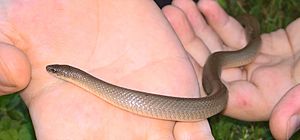Haldea striatula facts for kids
Quick facts for kids Haldea striatula |
|
|---|---|
 |
|
| Conservation status | |
| Scientific classification | |
| Genus: |
Haldea
|
| Species: |
striatula
|
| Synonyms | |
|
|
The rough earth snake (scientific name: Haldea striatula) is a small, harmless snake found in the southeastern United States. It used to be called Virginia striatula. This snake is not venomous, meaning it's safe for humans. It belongs to a group of snakes called colubrids.
Contents
About the Rough Earth Snake
The rough earth snake is a small, shy snake. It usually grows to be about 7 to 10 inches (18–25 cm) long. It has a round pupil in its eye. Its scales on its back are slightly ridged, which is called "weakly keeled." The belly of this snake is tan or whitish. It doesn't have a sharp color change from its back to its belly.
What Does It Look Like?
Rough earth snakes can be brown, gray, or reddish. They usually don't have any special patterns on their backs. Younger snakes might have a light band around their neck. This band usually disappears as they get older. Female snakes are a bit longer and heavier than males. Their tails are also shorter compared to males.
Similar Snakes
It's easy to mix up the rough earth snake with other small snakes. The smooth earth snake (Virginia valeriae) looks very similar. However, the rough earth snake has those slightly ridged (keeled) scales, while the smooth earth snake has smooth scales. The wormsnake (Carphophis amoenus) also looks a bit like it. But the wormsnake has a belly that is very clearly different in color from its back. Another snake that looks similar is De Kay's brown snake (Storeria dekayi). De Kay's brown snake is a little bigger. It also has dark markings on its back and neck that stay even when it's an adult. The rough earth snake loses its markings. De Kay's brown snake also has a rounder snout.
Where Rough Earth Snakes Live
You can find the rough earth snake in many parts of the southeastern United States. They live from southern Virginia down to northern Florida. They also live west along the Gulf Coast to southern Texas. You can find them north into south-central Missouri and southeastern Kansas.
Rough Earth Snake Habitat
These snakes like to hide. They are called "fossorial," which means they spend a lot of time underground or hidden. You can find them under logs, rocks, or even garden stones. They also hide in piles of leaves or compost. They like forests with lots of ground cover. They can even live in cities, in gardens, parks, and empty lots. In some city gardens, there can be many of these snakes living close together.
Rough Earth Snake Life Cycle
Rough earth snakes give birth to live young. This is called being "viviparous." They usually have 3 to 8 babies in the middle of summer. When they are born, the baby snakes are about 4 inches (10 cm) long. Baby rough earth snakes might look a bit like ring-necked snakes (Diadophis punctatus). They have a light-colored collar on their neck. But they are not as brightly colored and don't have a bright belly like ring-necked snakes.
Rough Earth Snake Behavior
Rough earth snakes are not aggressive towards people. They are not venomous and won't hurt you if you find one. Even though they have tiny teeth, they usually don't bite. If you bother them, they will try to stay still or escape. As a way to protect themselves, they might release a bad-smelling musk. This makes them less tasty to animals that might want to eat them. If you need to move one, you can safely pick it up by hand and put it somewhere else.
What Rough Earth Snakes Eat
The rough earth snake eats small creatures without backbones, called invertebrates. They mostly eat earthworms. Sometimes, they also eat slugs, snails, sow bugs, and insect eggs or larvae. Since they are not venomous, they don't bite to kill their food. They also don't squeeze their prey like some snakes do. Instead, they just swallow their food whole. Their pointed snout helps them dig in moist soil. This is where they find their favorite food, earthworms.
Images for kids
-
Rough Earthsnake (Haldea striatula), Harris County, Texas (16 March 2015)



